6 Wellness Tourism Management
Learning Objectives
In this chapters we will consider wellness management at the destination level as well as for individual wellness resorts. A brief description of the role governments and Destination Management Organizations (DMOs) may play in promoting and managing wellness destinations, is provided below. We will also consider the wellness resort management with a focus on how facets of the hospitality product can be designed and managed to contribute to well-being.
At the conclusion of this chapter students will be able to:
- Discuss the role of governments and associations in developing and marketing wellness tourism
- Discuss the role of Destination Management Organizations in marketing and managing wellness destinations
- Describe the role of nature and natural environments in promoting well-being
- Understand wellness resort management approaches with respect to the hospitality product that promote well-being, namely
- The Physical Product
- The Service Product
- Service Delivery, and
- The Service Environment
The Role of Government, Associations and Destination Management Organizations
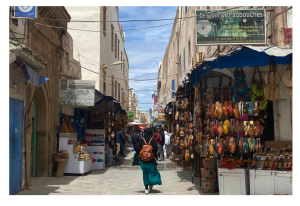 National and state governments may promote, develop, or manage particular regions as tourism destinations, as well as encourage niche forms such as wellness tourism. India’s Ministry of Tourism, for example, has actively marketed India as a top wellness destination, organizing campaigns, travel fairs, and roadshows to highlight the country’s wellness tourism offerings. Initiatives included a 2015 Yoga Day campaign, which gained widespread publicity and resulted in a surge of yoga-centric tours capitalizing on the country’s rich cultural heritage (Kumari, 2024).
National and state governments may promote, develop, or manage particular regions as tourism destinations, as well as encourage niche forms such as wellness tourism. India’s Ministry of Tourism, for example, has actively marketed India as a top wellness destination, organizing campaigns, travel fairs, and roadshows to highlight the country’s wellness tourism offerings. Initiatives included a 2015 Yoga Day campaign, which gained widespread publicity and resulted in a surge of yoga-centric tours capitalizing on the country’s rich cultural heritage (Kumari, 2024).
In 2023, the Indian Ministry of Tourism also introduced the more comprehensive National Strategy and Roadmap for Medical Wellness and Medical Tourism to enhance India’s standing as a premier wellness destination (Kumari, 2024). These initiatives aim to build a robust ecosystem for medical and wellness tourism development by improving infrastructure, ensuring ecological protections, enhancing access to technology, and providing an institutional framework to strategically plan and manage destinations (Kumari, 2024). For example, the strategy seeks to integrate marketing efforts and wellness providers into a seamless service chain (Kumari, 2024).
At the state level, in 2019, Kerala implemented a classification scheme for Ayurveda centers to ensure better quality and standardize services (The Hindu, 2019). All centers granted one of these ratings are required to append the phrase “Kerala Tourism Ayurveda Centre” to their name on brochures, signage and other communications to create a unified brand, thereby reinforcing Ayurveda as Kerala’s unique selling proposition, as well as to help tourists identify safe, authentic Ayurvedic facilities (The Hindu, 2019). Such facilities are also featured on the official Kerala Tourism website (The Hindu, 2019).
Alternatively, regions may be promoted by wellness associations. In Canada, for example, Wellness Travel BC is a marketing cooperative of travel partners that promotes wellness experiences across British Columbia and the Yukon. In collaboration with Destination British Columbia and other regional organizations like the Indigenous Tourism Association of BC, and the BC Hotel Association, the cooperative seeks to boost awareness and growth of wellness tourism in the region.
Destination Management Organizations
The term destination simply means a place to which a person is traveling, and has broad application (Britannica, n.d.). A destination may refer to a country, region, city, town, or, in the case of wellness tourism, even a full service wellness resort or event that visitors travel to in pursuit of holistic well-being (Okumus & Kelly, 2023; STR, n.d.).
At the state or municipal level destinations are typically represented by Destination Management Organizations (DMOs). DMOs operate as quasi-governmental, not-for-profit entities funded by transient room taxes, government budget allocations, and/or private membership, and play an important role in the strategic development, branding, and management of destinations (Fenich, 2017).
Within the United States, currently the leading market for wellness tourism, over 30 percent of states promote some form of wellness tourism on their official state tourism websites (Kessler et al., 2020). These websites may highlight local spas, retreats, and wellness activities, feature sections dedicated to wellness tourism, such as in Tucson, Arizona, or even brand themselves as a wellness destination, such as Mineral Wells, dubbed “The Wellness Capital of Texas.”
DMOs serve a strategic function as the “leading organizational entity that may encompass various authorities, stakeholders, and professionals to facilitate partnerships towards a collective destination vision” (Okumus & Kelly, 2023, p. 152). DMOs may also be involved in destination branding. For wellness destinations, branding begins with market research to identify wellness resources (see below) as well as understand the demands and expectations of wellness tourists (Dvorak et al., 2014). This information can then be used to establish a clear brand identity which differentiates a wellness destination from its competitors as well as attracts the desired tourist segments (He et al., 2023).
DMOs may also play an active role in the management of a destination by fostering collaboration among local businesses and stakeholders to ensure a seamless service chain and overall positive experience for visitors (Dvorak et al., 2014). For wellness tourism destinations a particular focus may include advocating for policies that support the sustainable growth of tourism to ensure the health and well-being of both tourists and local residents (Dvorak et al., 2014). Byron Bay, highlighted below, provides an example of successful wellness destination management, along with examples of a few additional strategic development, marketing and management roles that a DMO may play.
Wellness Resources
Wellness resources encompass the wellness services and amenities at a destination, as well as an areas endowed resources (Dvorak et al., 2014). Wellness services and amenities refer to those specialized services provided by local businesses, treatment centers, and facilities to enhance or support holistic well-being, as well as sport and recreational facilities, and outdoor recreational opportunities that visitors have access to at a destination (Dvorak et al., 2014).
Endowed resources refer to those tangible and intangible indigenous or distinctive assets which may be leveraged to create a wellness destination’s unique selling proposition or core competitive advantage as in the example of Ayurvedic facilities in Kerala, noted above. Endowed resources include a destinations natural assets, local culture, and reputation (Dvorak et al., 2014).
Endowed Resources
Natural assets refer to the features and characteristics of the local environment. These assets are particularly relevant as wellness tourism often relies heavily on the local topography and climate. Access to forests, lakes, mountains, oceans, or dry desert climates, for example, provide scenic attractions, therapeutic environments, and recreational spaces for physical and mental relaxation and rejuvenation (see Nature’s Benefits, below). In addition, natural springs, raw materials for body therapies such as mud and seaweed, or locally sourced produce for meal preparation may be incorporated into wellness facilities’ offerings.
Local culture includes contemporary culture as well as a destination’s heritage, in other words, the traditions, customs, values, artifacts, landmarks, and indigenous practices passed down through generations. Indigenous treatments or practices may include healing and self-development rituals (e.g., ayahuasca ceremonies in Peru), wellness therapies (e.g., Thai massage in Thailand), and spiritual guidance (e.g., ashrams in India).
Wellness destinations may offer opportunities for cultural immersion which can foster deeper, more emotionally fulfilling experiences for tourists (Balcioglu, 2024). The originality and credibility with which local culture is represented also contributes to a destination’s perceived authenticity (Dvorak et al., 2014). Research suggests that the authenticity of a destination’s service offerings is also highly valued by wellness tourists (Dahanayake et al., 2023).
Reputation refers to the overall perception or image of a destination. A positive reputation is essential to the success of a wellness destination, and destination management organizations (DMOs) play a key role in shaping and sustaining that public image. Developing a destination’s reputation involves leveraging its endowed resources to create a distinctive brand identity while ensuring the delivery of exceptional, wellness-focused services that offer a unique and fulfilling visitor experience (Dvorak et al., 2014). Since reputations are dynamic rather than static, DMOs must also actively coordinate efforts to maintain a destination’s reputation, for example, by closely monitoring and responding to online reviews (Dvorak et al., 2014).
Highlight: Byron Bay
Byron Bay is an iconic wellness destination in New South Wales, Australia. Known for its abundance of wellness offerings including alternative therapies, meditation, yoga, and health retreats, Byron Bay enjoys strong brand recognition both domestically and abroad.
Its evolution into a wellness hub began in the 1960s and 70s, when it first attracted surfers drawn to its consistent waves and laid-back coastal lifestyle. Soon after, free spirits and alternative lifestyle seekers followed, inspired by the area’s natural beauty and relaxed ethos. This foundation helped shape Byron Bay into the authentic haven for mindful living and holistic health that it is today.
Byron Bay’s success as a destination has also been supported by its endowed resources, which include:
Natural Assets
Byron Bay boasts an abundance of nature, attractive scenery, and a pristine environment, thanks to its diverse ecosystems safeguarded through the establishment of nature reserves and national parks. Byron Bay is renowned for some of the world’s best beaches, offering opportunities for surfing, swimming, and other water activities, as well as extensive wetlands that help maintain ecological balance. The region also features easily accessible waterfalls and rainforests while the iconic Cape Byron Headland Reserve offers stunning views, walking trails, and whale-watching opportunities. Additionally, Arakwal National Park, co-managed by the National Parks and Wildlife Service and the Arakwal Aboriginal people, highlights the area’s commitment to cultural and natural preservation.
Local Culture
The town’s residents are a diverse group of people from a wide range of backgrounds, but they share a love of Byron Bay, which shapes the town’s character. This collective ethos is evident in various aspects of local life, from the vibrant atmosphere of the town’s streets to the thriving arts scene, farmers’ markets selling local produce and artisanal goods, and an overall emphasis on laid-back living and sustainability. Additionally, the town’s indigenous heritage, particularly that of the Arakwal people, is integrated into community activities. Programs like “Dolphin Dreaming,” for example, provide tourists with opportunities to engage in storytelling, dance, and art that offer insights into the area’s cultural and ecological significance. In this way, Byron Bay maintains a strong sense of identity rooted in its local and indigenous culture.
Reputation
Byron Bay is renowned both nationally and internationally as a premier wellness destination, celebrated for its natural beauty, cultural richness, and commitment to mindful living. The town is also known as an authentic destination as it developed organically and still attracts a diverse range of alternative lifestyle seekers both as residents and tourists. Byron Bay’s rich, community-driven wellness experience is also sustained through local businesses, community groups, Indigenous custodians, and tourism organizations, all of which contribute to the town’s unique character.
Destination Management
As as destination, Byron Bay is now in the mature stage of development with significant tourism infrastructure. The town of just over 6,000 permanent residents boasts over 700 accommodation establishments offering a range of hotels, guesthouses, and wellness retreats at various price points. The town also faces its share of tourism-related challenges, such as balancing its unique character with the annual influx of visitors as well as problems with seasonal over-tourism and soaring prices.
In collaboration with various stakeholders, including government agencies and chambers of commerce, local DMO, Destination Byron, serves a key role in the marketing and sustainable management of this seaside town.
The following table, based on Destination Byron’s Destination Management plan for 2014-2020, offers some insight into the range of activities a DMO may undertake. Note that their plan highlights the importance of research and sustainable development to achieve a balance between tourism generated revenue and the preservation of the area’s unique natural assets, local character, and community values. Destination Byron also works in close collaboration with local government, namely Byron Shire Council, as well as businesses, and community organizations to implement its destination management strategies.
Research
|
|
Marketing
|
|
Destination Management
|
|
Communication and Education
|
|
Product Development
|
|
Visitor Services and Events
|
|
(Destination Byron, 2014; Wray et al., 2010)
Nature’s Benefits
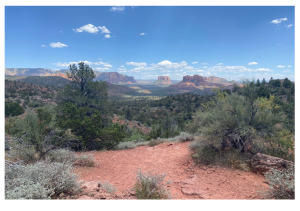 The importance of the natural environment to wellness tourism cannot be overstated. Since the Wellness Tourism Association began conducting consumer surveys in 2018, access to and experiences in nature have consistently ranked among the top priorities for wellness tourists (Whitby, 2021).
The importance of the natural environment to wellness tourism cannot be overstated. Since the Wellness Tourism Association began conducting consumer surveys in 2018, access to and experiences in nature have consistently ranked among the top priorities for wellness tourists (Whitby, 2021).
For wellness destinations, attributes such as natural beauty, fresh air, and connection with nature have also been shown to contribute to greater visitor satisfaction, revisit intentions, and positive recommendations (Lee & Kim, 2023). Unsurprisingly, while wellness resorts do exist in urban areas, the majority are located in more remote, natural settings such as rural regions, mountains, and alpine forests, often incorporating outdoor activities into their offerings (Bočkus et al., 2023; Urh, 2015). Blue tourism, which encompasses touristic activities in coastal areas and on beaches, is likewise popular among wellness tourists (Global Wellness Institute, n.d.).
Studies highlighting connections between the natural environment and holistic well-being help illuminate why nature-based settings are not only preferred by wellness tourists but may also be integral to the wellness tourism experience. For example, research has shown that exposure to green spaces is associated with reduced all-cause mortality, lower cardiovascular disease risk, and improved general health. Mitchell and Popham (2008) observed lower mortality rates from cardiovascular disease and other causes in neighborhoods with more green space. Ulrich (1984) found that hospital patients with views of natural areas recovered faster from surgery, required fewer painkillers, and reported fewer complaints compared to those with views of a brick wall. A study by Hartig et al. (2003) found that even brief exposure to natural settings led to improved blood pressure and heart rate recovery from stress compared to urban environments. Similarly, Maas et al. (2006) demonstrated a correlation between higher green space cover around homes and a greater percentage of residents reporting good or better health.
Grounding
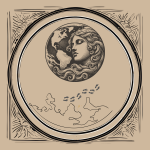 Grounding, also known as “earthing,” involves direct physical contact with the Earth’s surface, such as lying down or walking barefoot on grass, sand, or soil. Grounding is based on the concept that the Earth has a negative charge, and direct contact with the Earth’s surface helps restore the body’s natural electrical balance, neutralizing positively charged free radicals, reducing physical inflammation, and alleviating psychological stress. The practice also holds spiritual significance in many cultures, symbolizing a reconnection with Mother Nature to foster a sense of balance, spiritual alignment, and emotional nurturing.
Grounding, also known as “earthing,” involves direct physical contact with the Earth’s surface, such as lying down or walking barefoot on grass, sand, or soil. Grounding is based on the concept that the Earth has a negative charge, and direct contact with the Earth’s surface helps restore the body’s natural electrical balance, neutralizing positively charged free radicals, reducing physical inflammation, and alleviating psychological stress. The practice also holds spiritual significance in many cultures, symbolizing a reconnection with Mother Nature to foster a sense of balance, spiritual alignment, and emotional nurturing.
While grounding has been practiced for centuries, it has gained scientific attention in recent years. Research suggests various potential benefits, including reduced pain, improved sleep, decreased stress, and enhanced overall well-being (Chevalier et al., 2015). A study by Ghaly and Teplitz (2004) demonstrated that grounding can improve heart rate variability and reduce stress. Furthermore, a review by Oschman (2016) concluded that grounding could have significant physiological effects, including improved immune response and reduced inflammation.
In other empirical studies, participants reported significantly enhanced moods and attitudes after spending time in nature, including greater revitalization, self-esteem, positive engagement, vitality, energy, pleasure, and delight, along with reduced frustration, worry, confusion, depression, tension, and tiredness (Sandifer et al., 2015). Exposure to a greater variety of habitat types has also been linked to improved psychological well-being (Fuller et al., 2007), while access to nature, whether through urban parks, community gardens, or wilderness areas, was associated with reduced stress levels, improved mood, and enhanced cognitive function. Further studies suggest that exercise in natural environments similarly improves both mood and self-esteem and is more restorative than exercise in urban settings (Sandifer et al., 2015). Finally, research has highlighted the importance of natural settings for psychological and spiritual renewal by offering opportunities for relaxation, reflection, and restoration, and potentially fostering a sense of wholeness and connection to something greater (Gil et al., 2019). A typology of the ways in which nature, biodiversity, and ecosystem services contribute to human health and well-being* is presented in Table 6, below.
Table 6: Typology of Nature’s Benefits (Sandifer et al., 2015)
*Note that in this typology, nature is broadly defined “to include plants and other living things, natural and semi-natural areas including coastlines and mountains, parks, forests, wildlife sanctuaries, views of seascapes, and relatively undeveloped landscapes” (Sandifer et al., 2015, p. 5).
Theories of nature and well-being
In addition to the benefits outlined above, several theories, including the Biophilia Hypothesis, Attention Restoration Theory, and Stress Reduction Theory, have attempted to account for the underlying mechanisms behind the psychological benefits derived from nature, arguing for a profound and inherent connection between humans and the natural world. These are described in brief, below:
wellness resort management and well-being
In this section, we will consider how each element of the hospitality product may be designed or delivered to enhance guests’ experiences. The hospitality product, depicted in Figure 9 below, encompasses the entire experience purchased by a guest, each aspect of which must be effectively managed to ensure customer satisfaction (Shoemaker & Shaw, 2008) and, in the case of a wellness resort, promote holistic well-being (Liao et al., 2023).
Figure 9: The Hospitality Product (Shoemaker & Shaw, 2008)
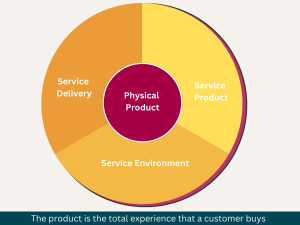
Physical Product
 The physical product refers to the tangible components of the hospitality product such as accommodations, food and beverage items, or amenities such as swimming pools (Shoemaker & Shaw, 2008). These components were identified in Chapter 5. In this section we will consider key architectural trends in the spa and wellness industry, which included breathtaking views, integration of local architectural styles, and sustainable, bio-inspired designs (Smith, 2021). The latter may include natural materials like locally sourced wood, stone, or eco-friendly bamboo, or feature elements like interior gardens (Smith, 2021).
The physical product refers to the tangible components of the hospitality product such as accommodations, food and beverage items, or amenities such as swimming pools (Shoemaker & Shaw, 2008). These components were identified in Chapter 5. In this section we will consider key architectural trends in the spa and wellness industry, which included breathtaking views, integration of local architectural styles, and sustainable, bio-inspired designs (Smith, 2021). The latter may include natural materials like locally sourced wood, stone, or eco-friendly bamboo, or feature elements like interior gardens (Smith, 2021).
Wellness tourists place high value on local heritage and wellness resorts frequently incorporate indigenous amenities, architectural motifs, or culturally significant design features that emphasize authenticity alongside sustainability (Dvorak et al., 2014). Place-specific amenities such as Turkish hammams, Japanese onsen, and Nordic saunas serve as culturally rooted wellness experiences and are often core attractions of wellness destinations in their respective regions (Bodeker & Cohen, 2010; Dvorak et al., 2014). When such amenities are offered outside their traditional settings, architectural or interior design features may be incorporated to lend a sense of authenticity and enhance the cultural experience for guests. For example, European hammams may feature rich tilework, intricate mosaics, and arches mimicking Moorish style, while onsen-inspired bathhouses frequently include natural hot spring baths, wooden soaking tubs, and stone or tile flooring, complemented by design elements like tatami mats and shoji screens.
Conversely, wellness resort chains like Six Senses leverage authenticity by exporting their brand to a wide variety of international destinations. Owned by InterContinental Hotels Group (IHG) since 2019, Six Senses specializes in sustainability-focused hospitality, emphasizing eco-friendly design, holistic wellness, and integration with nature and local cultures. The brand operates luxury wellness resorts and spas in remote, scenic locations, such as beaches, jungles, and mountains, offering immersive guest experiences rooted in indigenous heritage as well as reflected in architectural features. For example, in Thailand, the resorts incorporate natural materials such as locally sourced teak wood, along with traditional Thai design elements like open-air pavilions. In Bali, Indonesia, the wellness facilities include bamboo structures and organic gardens designed to blend seamlessly with the surrounding landscape, while in the Maldives, overwater villas and eco-friendly spas offer panoramic ocean views that connect guests with nature.
A caveat, especially for foreign investors or developers, is that wellness resort operators should be sensitive to cultural norms and values and ensure the cultural significance of indigenous practices is respected without exploitation or misrepresentation (Bentley, 2024). Engaging local communities in the wellness resort design and development process may help ensure authenticity, promote inclusivity, and prevent cultural appropriation or insensitivity by outside interests (Bentley, 2024).
Eco design may also be used to emphasize harmony with the natural and cultural environment. For example, Adobe-style resorts found in regions like the American Southwest, such as Canyon Ranch in Tucson, Arizona, incorporate architectural elements inspired by Native American Pueblo traditions. These designs blend with the natural environment by using locally sourced materials that harmonize with the surrounding landscape. They also incorporate sustainable design principles by, for example, utilizing thick, natural clay walls that provide excellent thermal mass, helping to maintain a comfortable indoor temperature by absorbing heat during the day and releasing it at night. Such features may strengthen guests’ connection to both the local landscape and heritage while minimizing ecological impacts.
Biophilic design principles, based on humans’ innate connection to the natural world, include elements that incorporate nature, offer views of greenery, maximize natural light, and use locally sourced or renewable materials such as wood, stone, and bamboo. For example, design elements that blur the boundary between indoor and outdoor environments, often called “transactional spaces,” such as continuous flooring and de-materialized walls, help foster seamless spatial flow between the built and natural environments (Goldfarb, 2008). A spa treatment room with sliding glass doors that open onto a private garden allows guests to feel immersed in nature, heightening the therapeutic potential of the service. Floor-to-ceiling windows with views of gardens, lakes, or mountain landscapes visually connect guests to nature, further supporting psychological well-being (Goldfarb, 2008). Large windows, skylights, and open-air structures also help maximize natural light, which is essential for regulating mood, promoting a sense of calm, improving sleep quality, and boosting vitamin D production (Goldfarb, 2008).
Material choice plays a crucial role in wellness design. Natural, eco-friendly materials such as wood, stone, and bamboo are favored for their lack of artificial chemicals and their sensory appeal. These materials are often chosen for their environmental benefits, as they typically lack the harmful substances found in synthetic alternatives. Natural stone, like granite, marble, or slate, is free of synthetic chemicals and often requires minimal processing, while bamboo, a renewable resource, naturally resists pests and does not require the chemical treatments used on other materials and certain hardwoods (Goldfarb, 2008). Nordic-style saunas with traditional natural wood interiors, such as spruce, pine, or cedar, are a prime example of how material choice in wellness design connects to biophilic principles. These woods, known for their durability and aromatic properties, contribute to the sensory experience of saunas. The use of natural wood also helps create a calming environment that encourages relaxation and stress relief, as its inherent warmth and texture reinforce a sense of groundedness and harmony with nature (Goldfarb, 2008).
Finally, sustainable management of wellness resorts reflects a growing convergence between wellness and sustainability (Smith, 2021). The emergence of the LOHAS (Lifestyles of Health and Sustainability) consumer segment, for example, underscores this broader trend. According to the Natural Marketing Institute, LOHAS consumers now represent over 20% of the consumer market in both the U.S. and Europe (Osti & Goffi, 2021). Wellness travelers likewise show a marked preference for eco-conscious destinations (Anju & Bindu, 2024). For wellness resort managers, this underscores the need to adopt sustainable management principles that not only meet evolving consumer expectations but also contribute to cultural and ecological preservation, safeguarding the local assets that form the foundation of this sector.
Accommodations
Design to enhance well-being in accommodations might focus on room features that encourage deep and restful sleep, as research has shown that good-quality sleep is a cornerstone of a healthy lifestyle and a vital component of well-being alongside diet and exercise (Matricciani et al., 2018). Since light is the single most powerful regulator of circadian rhythms, in addition to supportive mattresses, proper pillows, and breathable sheets, regulating light exposure is key (Suni & Rehman, 2023). A sufficiently dark bedroom can be achieved through blackout curtains or blinds, as well as the removal of electronic devices that emit even small amounts of light, to promote healthful sleep (Suni & Rehman, 2023). External noise may also disrupt sleep, so white noise machines or soothing music that mask disturbances and create a calm auditory environment can be added to bedrooms (Suni & Rehman, 2023).
Other well-being initiatives may include ensuring good ventilation and clean air, which not only contribute to improved sleep but also help prevent mold and reduce allergens(Suni & Rehman, 2023). Hypoallergenic bedding and air purifiers to maintain air quality may also be considered (Suni & Rehman, 2023). Sustainable initiatives to improve indoor air quality, such as advanced filtration systems, natural ventilation, and humidity control, further align with global sustainability trends and appeal to environmentally conscious travelers (Chandani & Yatawatta, 2025). Other factors that improve indoor environmental quality, in addition to air quality, include thermal comfort, acoustics, and indoor greenery all of which may have a significant and positive impact on guests’ overall well-being (Abdulaali et al., 2025).
Food and Beverage
Menus featuring healthful foods often describe using terms such as of “fresh, local, and quality food” , “nutritional foods” “healthy food”, and “indigenous cuisine” (Dini & Pencarelli, 2021) are key features of wellness resort as well as a means by which to enhance well-being. A list of generally accepted characteristics of healthful foods, is included under the seven principles of healthful food selection, below.
Traditional medical systems the world over viewed food as inseparable from medicine and considered the consumption of healthful foods an essential component of health, healing and longevity (Chen, 2008). A plethora of contemporary research has further demonstrated the benefits of natural foods (such as grains, legumes, vegetables, and fruits). Such foods are sources of fiber and provide essential nutrients, vitamins, and minerals, thus promoting and sustaining overall health, digestion and weight management, as well as reducing incidents of chronic diseases and preventing or potentially even reversing certain cancers (Donaldson, 2004).
Healthful foods also impact psychological and spiritual states. Psychological benefits include increased energy levels, and improved mood and emotional states, as well as mental clarity. Mediterranean style-diets, which are also associated with longevity, for example, were found to contribute to a 32% reduction in symptoms of depression (Okumus & Kelly, 2023). Serotonin, known as one of the “happiness hormones” is synthesized from amino acids found in foods such as eggs, pineapples, nuts, seeds, and salmon, while overall gut health has been shown to reduce stress and anxiety as well as alleviate symptoms of post-traumatic stress (Okumus & Kelly, 2023).
Many religious traditions include prohibitions or mandates that link food choices to the enhancement of spiritual well-being. In Hindu traditions, for example, the Sattvic diet—rich in fresh fruits, vegetables, whole grains, and dairy—is followed to support mental clarity and spiritual growth (Jacobs, 2019). The diet is believed to influence one’s state of consciousness, energy levels (prana), internal harmony, and emotional states, thereby contributing to a sense of balance and spiritual well-being (Jacobs, 2019).
Empirical research further highlighted the relationship between mindful eating and spiritual development. Kristeller and Jordan (2018) evaluated a Mindfulness-Based Eating Awareness Training (MB-EAT) program, which was designed to heighten awareness of the eating experience, including physical hunger and satiety cues, taste satisfaction, healthier food choices, and improved nutrition. Their research demonstrated that participation in MB-EAT led to significant increases in both emotional regulation and spiritual well-being, with the latter described in terms of personal meaning-making, inner peace, and a heightened sense of faith (Kristeller & Jordan, 2018).
Because sustainability is closely aligned with wellness, wellness resort managers may also promote environmentally responsible or low-impact (e.g. vegetarian, local, sustainably sourced) menus on their websites. Locally sourced food, for example, is not only fresher and healthier but is also considered a more sustainable option as it reduces food miles and supports local economies (Pirog, 2014). Some wellness resorts, such as Bardessono in Northern California, will even cultivate fruit and vegetable gardens onsite.
Organic food may also feature on wellness resort websites and menus. Organically grown food supports environmental health by improving soil quality, reducing chemical use, and increasing biodiversity (Meena et al., 2023). Consuming organic food is thus linked to reduced exposure to synthetic pesticide residue, for example, research indicates that the consumption of organic foods significantly lowered levels of pesticide metabolites in urine (Das, 2023). Another study demonstrated that an organic diet was associated with the detoxification and elimination of pesticide residue after just a one week stay at a wellness retreat (Cohen et al., 2017). Studies further suggest that organically produced foods may also contain higher levels of antioxidants and nutrients such as polyphenols, vitamin C, and omega-3 fatty acids, (Das, 2023). Organic plant foods also have a significantly higher amount of minerals such as magnesium, iron, phosphorus, calcium, sodium, potassium and zinc which are vital to healthy bodily functions (Das, 2023).
Finally, vegetarian or vegan items, which are diets associated with three primary motivations, namely consideration for animals, reducing environmental impacts, and avoiding adverse health effects associated with eating meat, are also commonly featured on wellness resort menus (Okumus & Kelly, 2023). Other common alternative diets and dietary preferences are described in the form of a short quiz at the end of this chapter.
characteristics of healthful foods
In Food and Healing, Annemarie Colbin outlines seven principles for healthful food selection (2013, p. xvi – xvii) as follows:

- Whole or minimally processed foods to optimize nutrient and energy absorption
- Fresh natural and organically grown foods, free of chemicals and additives
- Seasonal foods for fresher, nutrient-rich, and tastier options that sync with the seasons and environment
- Locally produced foods for fresher, nutrient-rich, and tastier options that support local economies
- Traditional or time-tested ingredients and preparation methods
- Balanced diets that include carbohydrates, healthy fats, protein, and essential micro-nutrients
- Delicious-tasting foods that enhance sensory enjoyment and serve as a guide to what the body crazes
Service Product
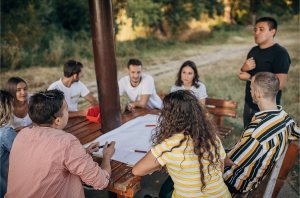 The service product is the core performance or services purchased by a guest and includes the intangible elements of service delivery over which management has control, such as program design, service standards and staff training (Shoemaker & Shaw, 2008).
The service product is the core performance or services purchased by a guest and includes the intangible elements of service delivery over which management has control, such as program design, service standards and staff training (Shoemaker & Shaw, 2008).
At a wellness resort, the core performance encompasses services centered on holistic well-being, such as health assessments, wellness workshops, fitness classes, and specialized treatments like spa and alternative therapies (Dvorak et al., 2014). While health practitioners, exercise instructors, dietitians, and holistic wellness practitioners etc. each require specialized training to deliver their respective services and modalities, in this section we will focus on a best practice approach to delivering activities and educational components, as well as the range and type of activities and overall tone set by staff that may enhance guests’ well-being. To this end, we will draw on Self-Determination Theory (SDT), first introduced in Chapter 3, to explore the link between program design and psychological well-being as the outcome of a stay at a wellness resort or retreat.
Self-Determination Theory
SDT, first introduced in Chapter 3, describes the satisfaction of basic needs, which we will review here, along with two related concepts, namely Intrinsic motivation and Mindfulness. According to SDT, psychological well-being is contingent on the satisfaction of three fundamental psychological needs, namely: Autonomy, Competence, and Relatedness (Ryan & Deci, 2019). Conversely, the thwarting of these basic needs can lead to increased unhappiness, stress, lack of personal growth, and over extended periods, even mental health disorders. Intrinsic motivation reflects our natural, spontaneous propensity to explore, learn, and grow while Mindfulness refers to a non-defensive, open awareness of experiences both within oneself and in the external environment (Ryan & Deci, 2019).
Autonomy reflects a sense of personal volition, where individuals feel their actions align with their true values and goals. It is not simply doing whatever one wants, but fully endorsing one’s actions internally. Social environments that offer meaningful choices and acknowledge individual perspectives foster autonomy, and by extension psychological well-being. In contrast, controlling environments undermine autonomy and reduce well-being. Importantly, autonomy complements rather than negates the need for relatedness as healthy relationships balance connection with the freedom to be oneself.
Relatedness refers to the fundamental human need to feel a sense of connection and belonging. It involves establishing meaningful relationships and experiencing a sense of shared purpose with individuals and groups and is essential to psychological well-being. When individuals experience a sense of relatedness, they feel more secure, cared for, and understood, which fosters positive emotions and a stronger sense of self-worth. Relatedness also facilitates positive health behaviors and outcomes as supportive social connections can act as a buffer against stress and promote resilience.
Competence is described as the inherent human drive to interact effectively with one’s environment in order to achieve desired goals and outcomes, and is also considered fundamental to overall well-being. When individuals feel competent, they experience a sense of mastery and effectiveness in their actions, leading to greater self-esteem. A sense of efficacy also empowers individuals to pursue their goals with confidence and resilience, contributing to a more fulfilling life as well as ability to overcome challenges. Perceived competence, for example, is highly correlated with positive patient outcomes in health care settings.
Need satisfaction plays a crucial role in fostering intrinsic motivation, or the inherent drive that energizes people to engage in activities they find interesting and enjoyable for their own sake, without the need for external rewards or prompts. However, this motivation does not arise in isolation; it is deeply influenced by the satisfaction of the three basic psychological needs. Specifically, when individuals experience autonomy (a sense of volition and personal endorsement), competence (a sense of effectiveness and mastery), and relatedness (a sense of meaningful connection with others), intrinsic motivation is maintained and strengthened. Conversely, need frustration undermines intrinsic motivation, making individuals more prone to depend upon external or controlled forms of regulation, as well as exhibit diminished or motivation or become entirely unmotivated.
Mindfulness is described as an open, non-judgmental awareness of internal and external experiences, promoting present-moment attention to thoughts, feelings, sensations, and surroundings (Ryan & Deci, 2019). Mindfulness is cultivated through practices such as meditation, mindful breathing, and intentional reflection, which strengthen attention, acceptance, and emotional balance over time. Mindfulness helps individuals align their actions with their values, by fostering greater self-awareness and emotional regulation, thereby enhancing autonomy and competence. It also supports relatedness by encouraging a deeper sense of empathy and genuine connection with others.
Based on the above descriptions, examples of elements of the service product that can be designed or orchestrated at a wellness facility to enhance well-being, is included in Figure 9, below.
Figure 9: Service Product to enhance well-being (Thal & Hudson, 2017)
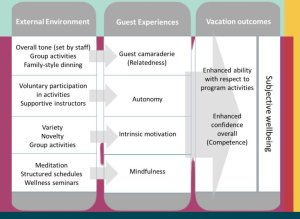
Autonomy, Competence and Structure

Autonomy and competence at a wellness destination can be facilitated by designing wellness programs around structure and personal agency. These, in turn, serve as the appropriate “scaffolding” to support personal mastery and, by extension, enhanced well-being.
At first glance, autonomy and structure might seem contradictory, but applied research suggests they share a synergistic relationship. Structure is not synonymous with control, but refers to environments that are organized to be optimally challenging by providing clear goals and stimulating growth. When balanced with autonomy support (whereby individuals feel their choices are self-endorsed rather than motivated by external punishments or rewards) and provided with the necessary guidance for goal achievement, individuals experience enhanced personal volition and improved goal related outcomes. Research further shows that this combination promotes self-regulated engagement, aligning with both competence and intrinsic motivation.
The widespread decline of health resort pejoratively termed “fat camps” perfectly illustrates why autonomy support is so vital to a successful wellness program. Such camps focused almost exclusively on extreme weight loss, measuring success by the number on the scale, with rewards or special privileges (e.g., access to additional food) granted only to those who achieved significant weight loss. Practices like weigh-ins reinforced a focus on weight as the sole measure of progress. Both nutrition and exercise approaches were often unsustainable, relying on overly restrictive diets and punitive physical practices. Food was heavily monitored, with treats like candy bars treated as contraband. Menus also emphasized “diet mentality” foods, including low- or zero-carbohydrate options, and reinforced an oversimplified “eat less, move more” strategy. Daily life was highly orchestrated and rigid, with campers often kept busy with events scheduled every half hour, engaging in six to eight hours of exercise six days a week. Exercise sessions also followed a “no pain, no gain” philosophy, without modifications for individual needs or physical conditions.
Despite such intense regimens, many programs only offered a temporary “fix,” without adequately preparing participants for long-term, sustainable behavior change once they returned home. A lack of attention to psychological factors, such as developing personal goals and emotional mastery over the process of change, left many feeling deflated or as if the camps were more like punishment than a path toward lasting well-being.
 By contrast, a well-designed wellness program should provide clear guidance and appropriate challenges (structure), while simultaneously validating each guest’s individual choices and perspective (autonomy support), to facilitate learning and growth (competence) as well as a sense of ownership over their personal wellness journey (autonomy). For instance, in a mindfulness workshop, facilitators might offer guests an in-depth introduction to the levels of attainment and benefits associated with meditation, along with different meditation techniques such as breath-work, body scans, or loving-kindness meditation, while outlining clear goals for each session. At the same time, participants may be encouraged to choose which practices resonate most with them and to progress at their own pace without pressure to “perform.” Such a process would not only lead to better immediate outcomes (in this case learning new mindfulness practices) but also contributes to lasting wellness by building confidence, competence, and a sense of agency over their personal development. In the same way, wellness programs that incorporate a range of educational components, such as healthful food preparation, mindfulness workshops, or wellness seminars, can help cultivate skills and foster intellectual and emotional growth (He et al., 2023; Dahanayake et al., 2023) that persist long after guests’ stay.
By contrast, a well-designed wellness program should provide clear guidance and appropriate challenges (structure), while simultaneously validating each guest’s individual choices and perspective (autonomy support), to facilitate learning and growth (competence) as well as a sense of ownership over their personal wellness journey (autonomy). For instance, in a mindfulness workshop, facilitators might offer guests an in-depth introduction to the levels of attainment and benefits associated with meditation, along with different meditation techniques such as breath-work, body scans, or loving-kindness meditation, while outlining clear goals for each session. At the same time, participants may be encouraged to choose which practices resonate most with them and to progress at their own pace without pressure to “perform.” Such a process would not only lead to better immediate outcomes (in this case learning new mindfulness practices) but also contributes to lasting wellness by building confidence, competence, and a sense of agency over their personal development. In the same way, wellness programs that incorporate a range of educational components, such as healthful food preparation, mindfulness workshops, or wellness seminars, can help cultivate skills and foster intellectual and emotional growth (He et al., 2023; Dahanayake et al., 2023) that persist long after guests’ stay.
Other measures to enhance program structure include providing set daily schedules that offer clarity and direction, as well as ease the mental burden of constant decision-making regarding activity selection. In a focus group at a wellness resorts, participants also expressed a strong preference for set schedules over unstructured stays (Thal & Hudson, 2017). However, as noted earlier, maintaining balance is key. Schedules should provide a framework, but they should also allow for maximum flexibility, with no prerequisites for engagement in any number of activities. Taking time away from scheduled activities for personal reflection, relaxation, and spontaneous activities, may also help guests “reset” or experience an enhanced ability to cope after returning to daily life, another noted benefit of a stay at a wellness facility (Thal & Hudson, 2017).
Relatedness
 The communal aspect is key….In addition to positive feelings in the moment (wellness) trips can act as temporary replacements for the many communities….provide a brief antidote to the competition people face in their everyday lives and a chance to enjoy like minded company. (Rubinstein, 2023)
The communal aspect is key….In addition to positive feelings in the moment (wellness) trips can act as temporary replacements for the many communities….provide a brief antidote to the competition people face in their everyday lives and a chance to enjoy like minded company. (Rubinstein, 2023)
Staff may play a crucial role in fostering relatedness at wellness destinations by creating an inclusive environment that encourages meaningful connections. Training staff to be attentive, empathetic, and skilled in facilitating social interactions can help set the “overall tone” and cultivate a “family atmosphere” where guests feel a sense of camaraderie and belonging. This is supported by research demonstrating the importance of qualities such as empathy for wellness professionals, as well as research that indicates positive interactions and relationships are essential to a fulfilling wellness experience (Kitchen, 2024). Positive guest interactions also provide opportunities to expand social networks and enhance social status, which are likewise desirable outcomes of a wellness stay (Wendri et al., 2019).
Wellness facilities can further promote interactions by providing communal spaces, scheduling group activities, and encouraging shared meals. For instance, at the Golden Door resort spa, Deborah Szekely famously reassigned guests around smaller dining tables to encourage meaningful conversations (Kitchen, 2024). Communal spaces like relaxation lounges, poolside areas, or outdoor terraces, along with group activities that encourage collaboration and shared experiences, such as paddle-boarding or nature walks, offer guests opportunities to connect with like-minded individuals. Group activities not only foster connection, but also increase enjoyment and participation in the activities themselves (Thal & Hudson, 2017). Activities based on shared passions and interests may even foster a strong sense of community and, by extension, lasting connections as well as individual well-being (Liberato et al., 2021).
Intrinsic Motivation
Wellness destinations effectively harness intrinsic motivation by orchestrating activities that are inherently enjoyable and fulfilling. For instance, by integrating novelty, variety and play into their offerings, wellness destinations can create an atmosphere that energizes guests, leading to enhanced satisfaction and well-being. This is supported by studies on involvement, which refers to a motivational state that influences attention, participation, and actions, and which has been shown to play a key role in shaping tourists’ experiences (Sthapit et al., 2023). When guests are highly involved, they tend to engage more actively, leading to more positive evaluations of their experiences and contributing to memorable stays (Sthapit et al., 2023).
Novelty and variety are important drivers of intrinsic motivation, as they tap into the human need for exploration and discovery. Novelty stimulates curiosity and engagement by introducing fresh experiences that break the routine. Wellness destinations that offer unique activities such as cacao ceremonies, aerial yoga, or forest bathing, for example, provide opportunities for guests to discover new passions and interests, making their stay more memorable. Variety across activities ensures a range of options, preventing monotony and encouraging interest and excitement. It can also help with engagement in activities, as, noted for example, “people will only make exercise a part of their lives when it is fun… Variety in exercise is what makes it fun” (Calistro, 1987).
Encouraging a sense of fun through play can also be particularly effective for supporting intrinsic motivation. Play is inherently rewarding, offering a sense of freedom, enjoyment, and social connection while promoting creativity, relaxation, and learning. Play can even induce a state of “flow,” where guests are fully immersed in an experience, further enhancing a sense of well-being (Jewel, 1997). By incorporating play into wellness offerings, whether through lighthearted games, group activities, or fun challenges, wellness destinations can encourage guest participation in otherwise less engaging activities. Deborah Szekely, who pioneered the wellness resort concept at Rancho La Puerta, recognized this early on, noting: “reviewing the calisthenics common at that time, I could see that they were often boring. I inserted games into exercises, or silly rhymes and most of all music” (Spivak, 1997, p. 68).
Mindfulness
Mindfulness supports autonomy, leads to more congruent and integrated ways of acting, buffers against compartmentalization and defensiveness, and is linked to lower stress, more adaptive coping strategies, and integrated self-regulation (Ryan & Deci, 2019). It can also enhance feelings of connected to other people, groups, communities, and even nature (Ryan & Deci, 2019).
Wellness resorts may offer a variety of mindfulness-based activities, such as yoga, workshops, and lectures on the practice and benefits of mindfulness, or through encouraging guests to disconnect from technology and become more aware of their surroundings (Bentley, 2024; Li et al., 2023). In addition, wellness resorts can encourage mindfulness through orchestrated activities like meditation sessions, journaling, and time spent in nature. Dedicated meditation rooms, designed to promote a sense of inner peace and calm, can further encourage guests to practice mindfulness techniques (Bodeker & Cohen, 2010). Even simply by providing peaceful settings where guests can relax and reflect, resorts can contribute to a more mindful experience (Sthapit et al., 2023).
Research indicates that meditation practices lead to greater medium-term improvements in mindfulness and emotional well-being compared to vacations without meditation (Blasche et al., 2023). Notably, in one study, the benefits of meditation, such as increased awareness and reduced fatigue, persisted for up to 10 weeks post-vacation, with minimal differences between intensive meditation retreats and vacations that offered less structured forms or limited meditation (Blasche et al., 2023). These findings align with previous research which suggest that integrating meditation not only positively impacts psychological well-being but can extend the restorative benefits of a wellness vacations (Blasche et al., 2023).
Service delivery
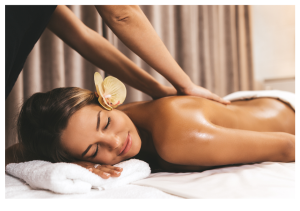
Service delivery refers to the service processes and professionalism that guests experience while interacting directly with staff (Shoemaker & Shaw, 2008). In wellness tourism, guest-staff interactions have been identified as a critical factor influencing overall satisfaction and destination appeal (Rodrigues et al., 2022). Without exceptional service, guests may find little justification for the added cost of a luxury spa or wellness resort (Stein et al., 1990, p. 51). In this regard, while smooth, reliable service processes remain essential, friendly and empathetic staff are key (Smith, 2021), with many guests citing staff warmth and welcoming attitudes as some of the most memorable aspects of their stay (Dahanayake et al., 2023).
A strong emphasis on service delivery is particularly critical for wellness resorts, as the guest experience relies heavily on high-contact interactions with specialists during health assessments, spa treatments, fitness classes, and alternative therapies. In these instances, technical expertise, cleanliness, and compassionate service are all essential for creating memorable wellness experiences and securing positive referrals. Past research shows that guests place high value on well-trained, knowledgeable practitioners who demonstrate empathy and attentiveness thorough procedural explanations, and a strong commitment to hygiene and privacy (Dahanayake et al., 2023). Additional research supports the idea that a satisfying tourism experience depends not only on the professionalism and skill of the wellness team but also on their ability to interpret guests’ moods, desires, and needs and fulfill those needs accordingly (Liberato et al., 2021).
Service Environment
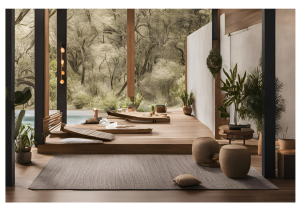
The final component, the service environment, encompasses both tangible and intangible elements that provide clues about the quality and type of service offered. These elements may also generate indirect benefits, such as a sense of security (e.g., deadbolt locks on guest room doors) or sophistication (e.g., freshly cut flowers) (Shoemaker & Shaw, 2008).
Dedicated spaces such as spas and therapy rooms are ideal for creating sensory-rich environments and fostering a holistic, immersive experience. Soothing sounds, like background music or the gentle flow of water, and soft lighting create a calming atmosphere (Sakallaris et al., 2015). Essential oils, known for their relaxation and stress-reducing properties, can be diffused or used in treatments to enhance the sensory experience (Cauchi & Falzon, 2023). Dann and Nordstrand (2009) likewise advocate for a multisensory approach that also prioritizes connection with nature through natural light, ventilation, and outdoor views. Interior design features and furnishings made from wood, stone, and bamboo further enhance a sense of connection with nature (Goldfarb, 2008).
Other elements that may be applied throughout a resort include cohesive spatial layouts and minimalist designs that reduce visual clutter, along with neutral or soothing color palettes that promote a sense of tranquility and order (Sakallaris et al., 2015). Together, such design elements form the tangible “face” of the wellness resort, embodying its core values and standards, and are a crucial aspect on the hospitality product. The results of one study went so far as to suggests that guests placed even great emphasis on the aesthetics and facilities than on the services delivered by staff at a wellness resort (Mishra & Panda, 2021). Intangible elements, such as ambience, naturalness, vividness, and peacefulness, have also been shown to have a significant impact on memorable wellness experiences (Dahanayake et al., 2023).
Finally, a clean environment, in addition to an attractive and calm atmosphere, is essential for wellness facilities (Smith, 2021). Cleanliness remains a cornerstone of customer satisfaction, just as well-maintained infrastructure is foundational to the guest experience. Moreover, the physical upkeep and cleanliness of facilities sends a clear signal regarding the overall quality and professionalism of a wellness destination.
Can you identify these alternative diets by name?
Can you match the lists of food with the best term to describe them?
Which knowledge, skills, and abilities are supported by this chapter?
Review Questions
- How do national and state-level initiatives in India contribute to the development and branding of wellness tourism?
- Explain the difference between wellness services/amenities and endowed resources in wellness tourism, and discuss how each contributes to a destination’s unique selling proposition and visitor experience.
- Discuss the importance of natural assets and local culture in wellness tourism, using Byron Bay as a case study, and describe how these elements influence destination reputation and visitor satisfaction.
- How do architectural and design elements in wellness resorts contribute to both guest well-being and cultural authenticity, and what are the potential challenges for foreign developers in incorporating indigenous features?
- Discuss how biophilic design principles and the choice of natural materials influence the sensory experience and psychological benefits for wellness resort guests. Provide specific examples from the text.
- How can wellness resort professionals apply principles of culturally rooted design, environmental sustainability, and wellness science (such as sleep optimization and sensory design) to create healing physical environments that enhance guest well-being?
- Explain how Self-Determination Theory informs the design and delivery of wellness programs.
- Discuss the role of relatedness and social connection in wellness destinations. How can staff and facility design foster meaningful interactions that contribute to guests’ overall well-being and satisfaction?
- Explain how incorporating novelty, variety, and play in wellness offerings can stimulate intrinsic motivation. Why are these elements important for engagement and memorable wellness experiences?
- What key features of service delivery and service environment contribute to creating a holistic, sensory-rich wellness experience? How do tangible and intangible elements influence guests’ perceptions of quality and well-being?
References
Abdulaali, H. S., Usman, I. M., Alawi, M., & Alqawzai, S. (2025). Research on guest comfort and satisfaction with indoor environmental quality in former GBI-certified green hotels: a study case from Malaysia. Frontiers in the Built Environment, Indoor Environment, 11, 1544177.
Ackerman. D. (1999, April 25). Why we need to play. Parade Magazine.
Anju, K. P., & Bindu, V. T. (2024). What Insights Does Service Quality Gap Analysis Offer for the Wellness Tourism Sector in Kerala?. Atna Journal of Tourism Studies, 19(2), 265-290.
Balcioglu, Y. S. (2024). Exploring consumer engagement and satisfaction in health and wellness tourism through text-mining. Kybernetes.
Bentley, L. (2024). The Role of Technology in Enhancing Health and Wellness Tourism Experiences. International Journal of Advanced Scientific Innovation, 6(6).
Blasche, G., DeBloom, J., Chang, A., & Pichlhoefer, O. (2021). Is a meditation retreat the better vacation? effect of retreats and vacations on fatigue, emotional well-being, and acting with awareness. PLoS One, 16(2), e0246038.
Bočkus, D. (2023). The market perspectives of wellness tourism: A multiple case study (Doctoral dissertation, Itä-Suomen yliopisto).
Bodeker, G., & Cohen, M. (Eds.). (2010). Understanding the global spa industry. Routledge.
Burnaz, E., Kurtuldu, H. S., & Akyüz, A. M. (2017). An organization structure suggestion of national destination management organizations for Turkey. Global Journal of Economics and Business Studies, 6(12), 46-63.
Calistro, P, (1987, August 9). The Latest Resorts : A New Kind of Spa Forgoes Both Frills and Fat-Farm Rigors in Favor of Fitness Re-Education. Los Angeles Times. Travel and Experiences. https://www.latimes.com/archives/laxpm- 1987-08-09-tm-358-story.html
Camilleri, M. A. (2018). The Tourism Industry: An Overview. In Travel Marketing, Tourism Economics and the Airline Product (Chapter 1, pp. 3-30). Cham, Switzerland: Springer Nature.
Cauchi, N., & Falzon, R. (2023). Enhancing wellbeing in beauty salons and spas through the integration of mindfulness and aromatherapy in beauty vocational education: a qualitative narrative inquiry. International Journal of Spa and Wellness, 6(3), 343-379.
Chandani, G. G. & Yatawatta, J. (2025, January). Enhancing guest experience in guest rooms through sustainable strategies for indoor air quality improvement in Sri Lankas luxury hotels. https://doi.org/0.31705/FARU.2024.15
Chen, N. (2008). Food, medicine, and the quest for good health : Nutrition, medicine, and culture. Columbia University Press.
Chen, K. H., Chang, F. H., & Wu, C. (2013). Investigating the wellness tourism factors in hot spring hotel customer service. International Journal of Contemporary Hospitality Management, 25(7), 1092-1114.
Chevalier, G., Sinatra, S. T., & Oschman, J. L. (2015). Earthing: Health Implications of Reconnecting the Human Body to the Earth’s Surface Electrons. Journal of Environmental and Public Health, 2015, 1-8. https://doi.org/10.1155/2015/720867
Cohen, M., & Bodeker, G. (2008). Understanding the Global Spa Industry: Spa Management. Butterworth-Heinemann.
Cohen, M. M., Elliott, F., Oates, L., Schembri, A., & Mantri, N. (2017). Do wellness tourists get well? An observational study of multiple dimensions of health and well-being after a week-long retreat. The Journal of Alternative and Complementary Medicine, 23(2), 140-148.
Colbin, A. (2013). Food and Healing: How what you eat determines your health, your well-being, and the quality of your life. Random House Publishing Group. ISBN:9780307833136, 0307833135
Cloutier, J. A. (2015). The Significance of Community in Wellness Service Design: The Case of Retreats (Doctoral dissertation, Master’s thesis, University of Tartu, Estonia), http://dspace. ut. ee/bitstream/handle/10062/49423/cloutier_josee-ann. pdf (accessed 10 March 2016).
Dahanayake, S., Wanninayake, B., & Ranasinghe, R. (2023). Unveiling the essence: Constructs of memorable wellness tourism experiences. Tourism and Hospitality Research, 14673584231223860.
Dann, G. & Berg Nordstrand, K. (2009) “Promoting well-being via multi-sensory tourism. In Sheldon, P & Bushell, R. (Eds.), Wellness and tourism: Nurturing mind, body, spirit and place (pp. 125-137). Cognizant, New York
Das, S. (2023). Impact of organic food and organic agriculture on human health and ecosystem. In Sarathchandran, Unni, M.R, Thomas, S. & Meena. (Eds). Organic Farming: Global Perspectives and Methods. (2nd ed.) Woodhead Publishing Series in Food Science, Technology and Nutrition. (pp. 255-289).
Deery, M., Filep, S., & Hughes, M. (2013). Exploring Visitor Wellbeing in Parks and Nature Reserves. In Voigt, C., & Pforr, C. (Eds.), Wellness Tourism: A Destination Perspective. (pp. 161 – 175). Routledge.
Destination Byron. (2014). Byron (don’t spoil us we’ll spoil you) Destination Management Plan 2014-2020. https://www.destinationbyron.com.au/research/
Dini, M., & Pencarelli, T. (2021). Wellness tourism and the components of its offer system: a holistic perspective. Tourism Review, 77(2), 394-412.
Donaldson, M. S. (2004). Nutrition and cancer: A review of the evidence for an anti-cancer diet. Nutrition Journal, 3(1), 19. https://doi.org/10.1186/1475-2891-3-19
Dvorak, D., Saari, S., & Tuominen, T.(Eds). (2014). Developing a competitive health and well-being destination. Turku University of Applied Sciences. https://www.theseus.fi/handle/10024/819660
Fenich, G. (2017). Meetings, Expositions, Events, and Conventions: An Introduction to the Industry. 5th ed. Upper Saddle River, NJ: Prentice Hall.
Ghaly, M., & Teplitz, D. (2004). The biologic effects of grounding the human body during sleep as measured by cortisol levels and subjective reporting of sleep, pain, and stress. Journal of Alternative and Complementary Medicine, 10(5), 767-776.
Gill, C., Packer, J., & Ballantyne, R. (2019). Spiritual retreats as a restorative destination: Design factors facilitating restorative outcomes. Annals of Tourism Research, 79, 102761.
Global Wellness Institute. (n.d.). Wellness Tourism Initiative Trends. https://globalwellnessinstitute.org/initiatives/wellness-tourism/wellness-tourism-initiative-trends/
Goldfarb, R. J. (2008). Theory Studied: Archetypical Practices of Contemporary Resort and Spa Design. Cornell University E-Commons. https://ecommons.cornell.edu/items/7c9e5441-7678-4382-be57-f62874a4e74b
He, M., Liu, B., & Li, Y. (2023). Tourist inspiration: How the wellness tourism experience inspires tourist engagement. Journal of Hospitality & Tourism Research, 47(7), 1115-1135.
Jacobs, S. (2019). A Life in Balance: Sattvic Food and the Art of Living Foundation. Religions, 10(1), 2. https://doi.org/10.3390/rel10010002
Jewell, D. L. (1997). Reflections on leisure, play, and recreation. SIU Press.
Kessler, D., Lee, J. H., & Whittingham, N. (2020). The wellness tourist motivation scale: A new statistical tool for measuring wellness tourist motivation. International Journal of Spa and Wellness, 3(1), 24-39.
Klemesrud, J. (1972, January 23). Tice Fat Farms—Or, How To Come Home A Real Loser. The New York Times. https://www.nytimes.com/1972/01/23/archives/the-fat-farms-or-how-to-come-home-a-real-loser-the-fat-farm-limit.html
Kolar, T., & Zabkar, V. (2010). A consumer-based model of authenticity: An oxymoron or the foundation of cultural heritage marketing? Tourism Management, 31(5), 652–664. https://doi.org/10.1016/j.tourman.2009.07.010
Kristeller, J. L., & Jordan, K. D. (2018). Mindful eating: Connecting with the wise self, the spiritual self. Frontiers in Psychology, 9, 1271. https://doi.org/10.3389/fpsyg.2018.01271
Kumari, A. (2024, November 14). Why India Leads In Wellness Tourism: Top Ayurvedic, Yoga, And Meditation Destinations. Outlook. Health Special. https://www.outlookindia.com/healths/why-india-leads-in-wellness-tourism-top-ayurvedic-yoga-and-meditation-destinations
Lee, J., & Kim, J. J. (2023). A study on market segmentation according to wellness tourism motivation and differences in behavior between the groups—focusing on satisfaction, behavioral intention, and flow. International Journal of Environmental Research and Public Health, 20(2), 1063.
Li, Y., Deng, Q., Peng, F., & He, M. (2023). Development and verification of the wellness tourism experience scale. Journal of Travel Research, 00472875231209493.
Liao, C., Zuo, Y., Xu, S., Law, R., & Zhang, M. (2023). Dimensions of the health benefits of wellness tourism: A review. Frontiers in psychology, 13, 1071578.
Liberato, D., Brandão, F., Teixeira, A. S., & Liberato, P. (2021). Satisfaction and loyalty evaluation towards health and wellness destination. Journal of Tourism and Development= Revista Turismo & Desenvolvimento, 2(36), 9-24.
Matricciani, L., Bin, Y. S., Lallukka, T., Kronholm, E., Wake, M., Paquet, C.,Dumuid, D., & Olds, T. (2018). Rethinking the sleep-health link. Sleep health, 4(4), 339-348.
Mishra, D., & Panda, R. K. (2021). How delightful is Indian wellness tourism? A netnographic study. Advances in Hospitality and Tourism Research (AHTR).
Molina, L. K. (n.d.). Map of Natural Hot Springs in the U.S. Databayou. https://databayou.com/usa/hotsprings.html
Ning, W. (2017). Rethinking authenticity in tourism experience. In The political nature of cultural heritage and tourism (pp. 469-490). Routledge.
Okumus, B., & Kelly, H. L. (2023). Wellness Management in Hospitality and Tourism. Goodfellow Publishers Ltd.
Oschman, J. L. (2016). Energy Medicine: The Science and Mystery of Healing. Elsevier.
Osti, L., & Goffi, G. (2021). Lifestyle of health & sustainability: The hospitality sector’s response to a new market segment. Journal of Hospitality and Tourism Management, 46, 360-363.
Pine, B. J., & Gilmore, J. H. (2007). Authenticity: What Consumers Really Want. Harvard Business Press.
Pirog, R., Miller, C., Way, L., Hazekamp, C., & Kim, E. (2014). The local food movement: Setting the stage for good food. MSU Center for Regional Food Systems. https://www.canr.msu.edu/foodsystems/uploads/files/Local_Food_Movement.pdf
Rodrigues, A., Loureiro, S. M. C., de Moraes, M. L., & Pereira, R. G. (2022). Memorable tourism experi-ence in the context of astrotourism. Anatolia, Advance online publication. https://doi.org/10. 1080/13032917.2021.2015695
Rubinstein, P. (2020, February, 4). How the wellness industry is taking over travel. BBC. https://www.bbc.com/worklife/article/20200203-how-the-wellness-industry-is-taking-over-travel
Ryan, R. M., & Deci, E. L. (2019). Brick by brick: The origins, development, and future of self-determination theory. In Advances in motivation science (Vol. 6, pp. 111-156). Elsevier.
Sakallaris, B. R., Macallister, L., Voss, M., Smith, K., & Jonas, W. B. (2015). Optimal healing environments. Global advances in health and medicine, 4(3), 40-45.
Sandifer, P. A., Sutton-Grier, A. E., & Ward, B. P. (2015). Exploring connections among nature, biodiversity, ecosystem services, and human health and well-being. Ecosystem Services, 12, 1–15.
Smith, M. K. (2021) Creating Wellness Tourism Experiences, in R. Sharpley (ed.) Routledge Handbook of the Tourist Experience, Chapter 26, London: Routledge.
Sthapit, E., Björk, P., & Coudounaris, D. N. (2023). Towards a better understanding of memorable wellness tourism experience. International Journal of Spa and Wellness, 6(1), 1-27.
Suni, E. & Rehman, A. (2023, November 8). How to Design the Ideal Bedroom for Sleep. Sleep Foundation. https://www.sleepfoundation.org/bedroom-environment/how-to-design-the-ideal-bedroom-for-sleep
Thal, K. I. (2015). Self-Determination Theory and Wellness Tourism: How Do Wellness Facilities Contribute to Wellbeing?. University of South Carolina Scholar Commons. https://scholarcommons.sc.edu/etd/3133/
Thal, K. I., & Hudson, S. (2019a). A conceptual model of wellness destination characteristics that contribute to psychological well-being. Journal of Hospitality & Tourism Research, 43(1), 41-57.
Thal, K., & Hudson, S. (2019b). Using self-determination theory to assess the service product at a wellness facility: a case study. Journal of Hospitality and Tourism Insights, 2(3), 260-277.
The Hindu. (2019, July 24). Ayurveda centres in Kerala Tourism’s quality net: New classification scheme in place for centres. https://www.thehindu.com/news/national/kerala/ayurveda-centres-in-kerala-tourisms-quality-net/article28693004.ece
Voigt, C., Brown, G., & Howat, G. (2011). Wellness tourists: In search of transformation. Tourism Review, 66(1/2), 16–30. https://doi.org/10.1108/16605371111127206
Wendri, I. G. M., Bakta, I. M., Suprapti, N. W. S., & Ardika, I. W. (2019). Various factors contributive toward tourist intention in enjoying wellness tourism. International Journal of Linguistics, Literature and Culture, 5(3), 61-70.
Whitby, M. (2021, October 7). WTA’s 2021 survey reveals key consumer preferences for future wellness tourism and travel. https://www.spabusiness.com/wellness-news/WTAs-2021-survey-reveals-key-consumer-preferences-for-future-wellness-tourism-and-travel/348554
Wray, M., Laing, J., & Voigt, C. (2010). Byron Bay: An alternate health and wellness destination. Journal of Hospitality and Tourism Management, 17(1), 158-166.

